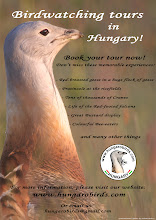Thursday, 22 January 2009
Birds in 2008
Last year we began our tours at our ricefields. Black storks, cranes, herons and waders looked for food there. The summer was interesting as well: our red-footed falcons and sakers were feeding the chicks. The autumn sky was noisy by the cranes and geese. In Last year the Hungarobirds team observed 268 bird species. You can download the checklist here: www.hungarobirds.com/eveslista
Monday, 19 January 2009
Study trip to England
Next month two of our staff are visiting to England. Our friends will guide us into the English birding and twicher culture and practice. We are visiting to the Wetland Centre in London, a few reservoirs and another high value nature reserves around London.
We visiting to the other effect as well: to meet our partners, to seek new ones and to do promotion for our tours.

We visiting to the other effect as well: to meet our partners, to seek new ones and to do promotion for our tours.

Tuesday, 13 January 2009
Long-eared Owls in Túrkeve
Harsh winter in the Hungarian Great Plan
 Today we had a guided birdwatching tour into the winter Puszta. In the morning there was -15 Celsius, but the temperature was frosty in the afternoon as well. Buntings, thrushes, finches were the most common birds, but we saw a few White-tailed Eagles, Black Woodpeckers and Great White Egrets too. The trees had a white rime wintercoat, the lakes a 20 cm thick ice, so after thise frosty experience we loved to drink a hot mulled wine.
Today we had a guided birdwatching tour into the winter Puszta. In the morning there was -15 Celsius, but the temperature was frosty in the afternoon as well. Buntings, thrushes, finches were the most common birds, but we saw a few White-tailed Eagles, Black Woodpeckers and Great White Egrets too. The trees had a white rime wintercoat, the lakes a 20 cm thick ice, so after thise frosty experience we loved to drink a hot mulled wine.
Saturday, 10 January 2009
Feathers: Identification for bird conservation
 I would like to announce that the guide "Feathers: Identification for birdconservation" by Marian Cieslak and Boleslaw Dul is available via internet at new price. It is an excellent guide for bird feathers identification by Marian Cieslakand Boleslaw Dul as an effect of 15 years of their research and studies. Theguide is illustrated with over 250 photos and feathers are presented as awing formula of 60 species of bird of which 38 are included in Annex I ofthe EU's Birds Directive. This book mainly covers diurnal species of birdsof prey (Falconiformes) and owls (Strigiformes) and species wich featherscould be confused with them.More information and how to order the book you can find here:
I would like to announce that the guide "Feathers: Identification for birdconservation" by Marian Cieslak and Boleslaw Dul is available via internet at new price. It is an excellent guide for bird feathers identification by Marian Cieslakand Boleslaw Dul as an effect of 15 years of their research and studies. Theguide is illustrated with over 250 photos and feathers are presented as awing formula of 60 species of bird of which 38 are included in Annex I ofthe EU's Birds Directive. This book mainly covers diurnal species of birdsof prey (Falconiformes) and owls (Strigiformes) and species wich featherscould be confused with them.More information and how to order the book you can find here:The book is also available in NHBS
Friday, 9 January 2009
The first Waxwing this year
Sunday, 4 January 2009
Nest monitoring in our local area
 After a long planning we began a nest monitoring in our local area. We followed the lead of the National Park: we had to write a note about the nest, a GPS position, type of the tree, what kind of birds of prey uses the nest. The enthusiastic team roamed about the riverside of the Hortobágy-Berettyó. We worked all day long, but we had a pass mark: we found a few buzzard and goshawk nests.
After a long planning we began a nest monitoring in our local area. We followed the lead of the National Park: we had to write a note about the nest, a GPS position, type of the tree, what kind of birds of prey uses the nest. The enthusiastic team roamed about the riverside of the Hortobágy-Berettyó. We worked all day long, but we had a pass mark: we found a few buzzard and goshawk nests.
Subscribe to:
Comments (Atom)



